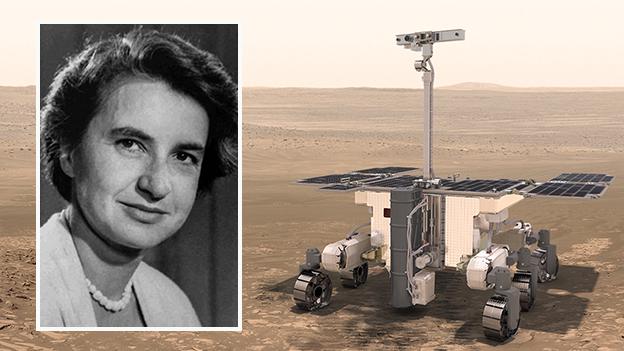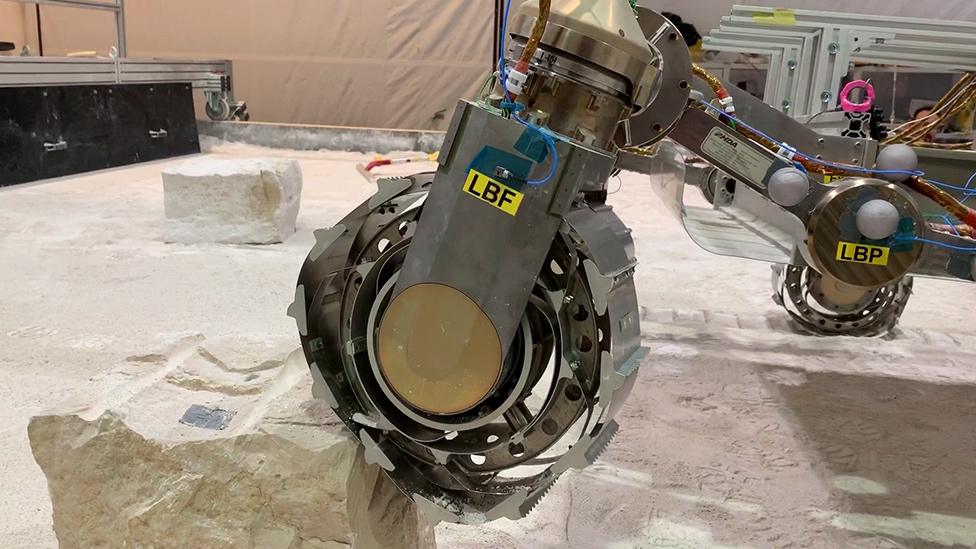Rosalind Franklin: Mars rover control centre opens
- Published

The control centre can run simulations before sending commands up to Mars
The control centre that will run day-to-day operations during the Rosalind Franklin rover's exploration of Mars in 2021 has been inaugurated in Turin.
The Italian facility will be where engineers sit and communicate with the robot vehicle via a satellite that is already in orbit around the Red Planet.
Rosalind Franklin is a joint venture between the European and Russian space agencies (Esa and Roscosmos).
Its mission is to drill into Mars to see if life has ever been present.
Esa's director-general, Jan Wörner, said of the new Rover Operations Control Center (ROCC): "This is the crucial place on Earth from where we will listen to the rover's instruments, see what [Rosalind Franklin] sees and send commands to direct the search for evidence of life on and under the surface."
The ROCC is located on the premises of Altec, an engineering and logistics services company set up by the Italian Space Agency and Thales Alenia Space (TAS).
TAS is the industrial prime contractor engaged by Esa to develop the rover and all its systems.
Assembly of the vehicle itself has been subcontracted to another of Europe's major aerospace companies, Airbus.
Final integration of the six-wheeled scientific machine is nearing completion in a cleanroom in Stevenage, UK.
Allow X content?
This article contains content provided by X. We ask for your permission before anything is loaded, as they may be using cookies and other technologies. You may want to read X’s cookie policy, external and privacy policy, external before accepting. To view this content choose ‘accept and continue’.

Three rovers are actually being constructed as part of the mission.
The first, called the "Structural Thermal Model" (STM), was used to prove the design.
This STM went through a tough testing regime to check that the robot that does eventually launch to Mars - the "Flight Model" now in Stevenage - will be able to cope with the stresses of working on another planet.
The third model, also not quite finished, is called the "Rover Ground Test Module".
This is essentially the copy of Rosalind Franklin that will be kept on Earth at the ROCC to troubleshoot any problems.
If engineers need to re-write a piece of software to overcome some glitch on the Flight Model, the patch can be trialled first in the Turin Test Module before being sent up to the Red Planet.
Some problems may be more physical in nature, such as an obstacle like a sand trap or large boulder.
Again, the ROCC's engineers will be able to practise avoidance and escape manoeuvres with a dummy rover model in a large sandpit before asking the real robot on Mars to follow the same movements.
Rosalind Franklin is due to launch to the Red Planet in July/August next year and land in March 2021.

The rover's name: Who was Rosalind Franklin?

The Rosalind Franklin rover is a joint project of Europe and Russia
In 1952, Rosalind Franklin was at King's College London (KCL) investigating the atomic arrangement of DNA, using her skills as an X-ray crystallographer to create images for analysis.
One of her team's pictures, known as Photo 51, provided the essential insights for Crick and Watson to build the first three-dimensional model of the two-stranded macromolecule.
It was one of the supreme achievements of 20th Century science, enabling researchers to finally understand how DNA stored, copied and transmitted the genetic "code of life".
Crick, Watson, and KCL colleague Maurice Wilkins received the 1962 Nobel Prize for the breakthrough.
Franklin's untimely death meant she could not be considered for the award (Nobels are not awarded posthumously). However, many argue that her contribution has never really been given the attention it deserves, and has even been underplayed.

Jonathan.Amos-INTERNET@bbc.co.uk, external and follow me on Twitter: @BBCAmos, external
- Published17 May 2019

- Published10 May 2019

- Published2 April 2019

- Published7 February 2019

- Published14 December 2018

- Published9 November 2018
